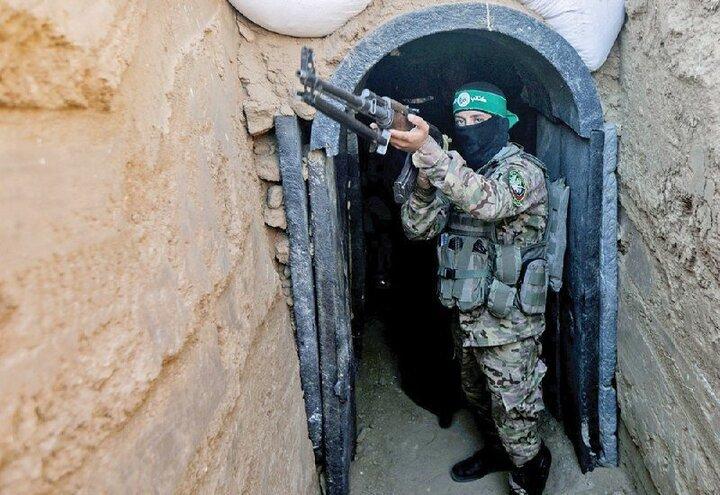Gaza quagmire
Rather, the group has inflicted a disaster and a headache on the Israeli military and political leadership.
After some 50 days of the Israeli war on Gaza, Hamas' armed wing, the al-Qassam brigades, has maintained its presence on the ground and under the ground across the entire Gaza Strip.
Its armed members have fought off the heavy Israeli ground offensives in the northern Gaza Strip, frustrating the cabinet of Israeli Prime Minister Benjamin Netanyahu further.
The occupation army's repeated statements that Hamas’ leadership and control in the northern Gaza Strip have been damaged, or that "Hamas brigades in the north have been destroyed" is exactly the opposite of the events that had been unfolding on the ground.
But it does highlight the weakness of the regime's military. In Gaza, Israel has faced the bitter reality of its army being unable to engage in hand-to-hand combat with Hamas fighters. Israel has long been accustomed to what can be called remote war, a type of battle involving more aerial combat and less ground invasions. And even the ground invasions that Israel carried out over the course of its bloody history were done only after heavy aerial bombardment. The Gaza war, however, is a different story. Israel has been trying to advance in the enclave for nearly 50 days, without any tangible success.
With their October 7 operation, the Hamas resistance group tore down Israel’s fig leaf, revealing strategic weaknesses in Israel’s military. Many observers believe that Israel has forever lost its self-proclaimed deterrence. In a bid to restore its shattered sense of invincibility, Israel has resorted to carpet bombings and mass destruction in Gaza, which created a humanitarian disaster of historic proportions.
Despite its war crimes in Gaza, Israel appears to be keen to find a way out of the quagmire. The Israeli regime and Hamas agreed to extend the current truce for another day. The Wall Street Journal reported Monday that negotiations were underway to extend the truce for four days.
The temporary truce to exchange Israeli hostages and Palestinian women and children in Israeli prisons could not have come soon enough for Israeli Prime Minister Benjamin Netanyahu.
The ceasefire has allowed the Israeli war criminal and his cabinet the opportunity to sit down and reconsider the military strategy amid growing international outrage at the unprecedented Israeli onslaught of Palestinian civilians.
The main question is if the Israeli military continues with its indiscriminate attacks against Palestinian civilians once the temporary truce ends, will the regime continue to bomb hospitals and alarm the United Nations further?
After 50 days of attacks, the regime's military does not appear to have a second option.
It has been proven that Hamas cannot be defeated. Not by warplanes, not by warships and certainly not by an extremely large ground battalion.
Even the Israeli settler population and the regime's media outlets are not buying this fake Israeli propaganda campaign.
After the most intense bombardment of the tiny and yet very densely populated territory, Hamas has managed to coordinate the release of Israeli hostages.
This alone shows the group's coordination and communication channels remain intact.
The commitment of the resistance factions, with their leadership directing them toward a ceasefire, is another indication of a high level of integrity.
The process of releasing hostages from the Gaza Strip is taking place exactly as Hamas wants.
The group is the party that is dictating the identity of the hostages who are being released. Hamas is setting the schedules and the time period for their release as per the terms of the temporary truce it agreed to.
At times, it has delayed the release of hostages if insufficient trucks of aid have been delivered to the northern Gaza Strip, which is in violation of the terms that Hamas stipulated in the deal.
Hamas has also succeeded in demonstrating its ability to send its members from across the coastal enclave to northern Gaza despite the presence of a very heavy Israeli military presence nearby.
At the highest estimate, it is believed that several hundred Hamas members may have been killed. It could be less, but the remainder (tens of thousands killed, injured, and under the rubble) have all been civilians.
Hamas leader Yahya Sinwar and the regime's number one target for assassination since October 7 remains active and is masterminding the group's resistance activities, which have thwarted and frustrated the regime's ground invasion.
Should the Israeli military continue these indiscriminate attacks and blockade on the people of Gaza, the growing Palestinian civilian death toll will inevitably rise to an extent that international pressure may force the regime to end its war.
Over the past two decades?, when the Israeli military waged murderous wars against the resistance in the Gaza Strip or Lebanon's Hezbollah, history shows that at the end of the regime's death and destruction campaign that it commits, the Zionists will eventually release the Palestinian political prisoners it holds in exchange for the Israeli military hostages under the captivity of the resistance.
Should the regime expand its war crimes, it also risks expanding the arena of combat to regional countries.
This is something that the United States, whose military bases are scattered across the region, has publicly declared that it does not want this type of escalation to happen.
The fear of the U.S. is that any expansion of the war to other regional fronts would put the lives of its own military personnel in the West Asia region at risk, which is a major headache for the Americans who are already directly engaged in another major war in Eastern Europe.
What is clear is that Hamas is far from collapsing or even close to a breaking point, and the Israeli media outlets have admitted this fact themselves.
The regime risks losing its alleged superiority against the Palestinians having engaged in one of the longest wars against the blockaded Gaza Strip to "wipe out Hamas", but is very far from reaching anywhere near that kind of achievement against the Palestinian resistance group.
At the end of the day, this is the price that the Israeli occupation will have to pay.
History repeats itself once again.
The people of Gaza are Hamas and Hamas are the people of Gaza.
The same goes for Hezbollah, for instance. The people of Lebanon and Southern Lebanon, in particular, are Hezbollah and Hezbollah are the people of Lebanon.
Unlike Daesh, Hamas and Hezbollah are not an ideology, they are the people of the region, defending them against Israeli aggression and war crimes.
You might be able to break an ideology like Daesh. What you can't break is the people, especially the people of Gaza.
By Ali Karbalaei
First published by Tehran Times
News source: Mehr News ![]()
Related news: Gaza quagmire
Copyright © 2001-2024 - Sarkhat.com - About Sarkhat - News Archive - جدول لیگ برتر ایران

